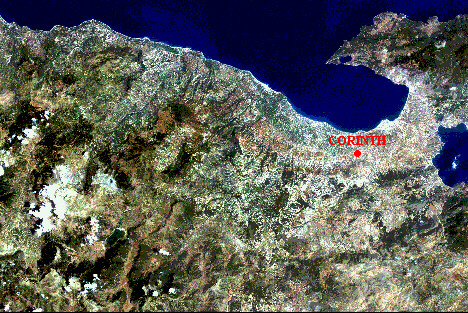The Corinth Computer Project
Reconstructing the city plan and landscape of Roman Corinth
Dr.
David Gilman
Romano, Director


© EOSAT
Since 1988 a research team from the Mediterranean Section of The
University of Pennsylvania Museum of Anthropology and Archaeology has been involved in
making a computerized architectural and topographical survey of the Roman
colony of Corinth. Known as the Corinth Computer Project, the field work has
been carried out under the auspices of the Corinth Excavations of the American
School of Classical Studies at Athens, Dr. Charles K. Williams, II, Director.
Although the excavations at Corinth by the American School have been
underway for a century, aspects of the study of the layout of the
Roman colony have remained incomplete due to the size and complexity of
the site as well as its complicated history. Our original objectives were to
study the nature of the city planning process during the Roman period at
Corinth; to gain a more precise idea of the order of accuracy of the Roman
surveyor; and to create a highly accurate, computer generated map of the
ancient city whereby one could discriminate between and study the successive
chronological phases of the city's development.
It is important to acknowledge that during the course of the nine years of
the project to date, the nature of the research has evolved from a fairly
straightforward consideration of the location and orientation of the excavated
roadways of the Roman colony, to a more complex topographical and
architectural consideration of various elements of the colony, including the
rural as well as the urban aspects of planning and settlement. The project
now utilizes a number of methodologies, simultaneously, in the overall study
of the ancient city. One aspect of the project is a regional landscape study
of a portion of the Corinthia, with the city of Roman Corinth as the focus.
Another aspect of the project is the effort to include information from the
city of Corinth from chronological periods other than Roman, specifically
Archaic and Classical Greek, Hellenistic, Late Roman, Byzantine, Frankish,
Venetian, Turkish and modern. By means of low level and high altitude air
photography, as well as satellite images and some balloon photographs,
the limits of the project have been greatly expanded into areas that had not
been considered in the original research design.

© 1996 David Gilman Romano.
Released January 22, 1997.
If not otherwise stated, all texts, photographs and graphics are copyrighted by Dr. David Gilman Romano and the Corinth Computer Project.

If you have questions or comments concerning the Corinth Computer Project
please contact us via email at dromano@ccat.sas.upenn.edu.
Webdesign by: Nicholas
L. Stapp
& Warren
M. J. Petrofsky, 1996.





